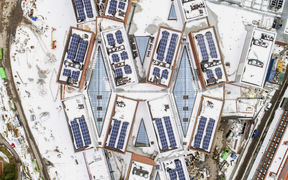School as a Service

In autumn 2016, Aalto University's Otaniemi campus became home to new activities as 350 students from Haukilahti Upper Secondary School started their studies on the campus. The school will interact closely with university students and staff.
The idea for the whole new school solution came from an R&D project concerning teaching service architecture, which was led by Jarmo Suominen, professor at the Department of Architecture at Aalto University, and it was refined during multi-disciplinary courses in Espoo, London and Shanghai. The City of Espoo was excited about the concept to develop temporary school facilities and decided to test this idea.
The high school utilizes the facilities of Aalto University and other building owners for example in sports, physics and chemistry, in addition to dining. These facilities typically have a fairly low percentage of use even during a normal schoolday. By utilizing the resources of other actors, the high school reduces the operational expenses, lowers the carbon footprint of its functions and enables a greater flexibility in arranging education.
Vice president Antti Ahlava has been responsible for the partnership project at Aalto University:
‘School as a service is a new revolutionary idea, in which the school is seen as a platform that supports learning. In this concept, the activities and physical structure of the school are kept separate. Branching operations to our city district supports pedagogic objectives of social and theme-based learning, and the upper secondary school becomes a natural part of the university campus and its culture.’
Ahlava continues:
‘We planned this concept following a participating method: the process involved future users of the facilities as well as students and experts from Aalto University. Furthermore, the London Royal College of Arts and its service designers took part in the project.’
One purpose of this experiment is to test flexible and cost-efficient operating models that can later be expanded and scaled to apply to other educational institutes and services. The experiences and ideas resulting from this project can be utilised, for example, in situations where a school needs to temporarily move from its regular facilities.
Eetu Ristaniemi, Director of Real Estate Investments at Aalto University Campus & Real Estate, describes the project:
‘The Saas-model is a new method for conducting real estate business, where, among others, Aalto University sells its spare capacity to other actors that can utilize it. Typically in the real estate sector, vacant spaces are monitored, but in the global scale low utilization rates are a big structural problem that is hardly discussed. Particularly from the environmental perspective, the most harmful square meter is a square meter that is not in use. In addition, from the building owner or operator point of view, an unused hour is also a wasted profit.’
At first, Otaniemi will be home to 350 students from Haukilahti Upper Secondary School. The school will operate in Otaniemi until the renovation and expansion of the Haukilahti school building are completed. In the city's investment program, these have been scheduled for 2018–2020. Later, the number of students in the Otaniemi facilities may increase to 700.
This experiment will be carried out in close cooperation with Aalto University and other different parties. The plan is to set up a separate development community for the partners.
Sustainable campus
The key environmental impacts of the campus are related to energy consumption and transport. A sustainable and carbon neutral campus is at the core of the campus strategy.

- Published:
- Updated: